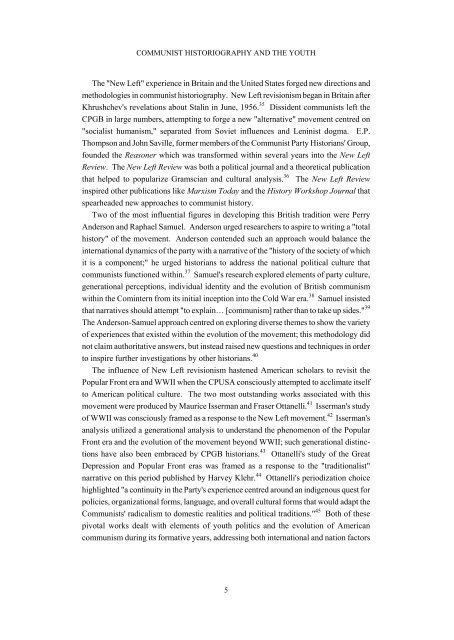Joel A Lewis Youth Against Fascism.pdf
Joel A Lewis Youth Against Fascism.pdf
Joel A Lewis Youth Against Fascism.pdf
Create successful ePaper yourself
Turn your PDF publications into a flip-book with our unique Google optimized e-Paper software.
COMMUNIST HISTORIOGRAPHY AND THE YOUTH<br />
The "New Left" experience in Britain and the United States forged new directions and<br />
methodologies in communist historiography. New Left revisionism began in Britain after<br />
Khrushchev's revelations about Stalin in June, 1956. 35 Dissident communists left the<br />
CPGB in large numbers, attempting to forge a new "alternative" movement centred on<br />
"socialist humanism," separated from Soviet influences and Leninist dogma. E.P.<br />
Thompson and John Saville, former members of the Communist Party Historians' Group,<br />
founded the Reasoner which was transformed within several years into the New Left<br />
Review. The New Left Review was both a political journal and a theoretical publication<br />
that helped to popularize Gramscian and cultural analysis. 36 The New Left Review<br />
inspired other publications like Marxism Today and the History Workshop Journal that<br />
spearheaded new approaches to communist history.<br />
Two of the most influential figures in developing this British tradition were Perry<br />
Anderson and Raphael Samuel. Anderson urged researchers to aspire to writing a "total<br />
history" of the movement. Anderson contended such an approach would balance the<br />
international dynamics of the party with a narrative of the "history of the society of which<br />
it is a component;" he urged historians to address the national political culture that<br />
communists functioned within. 37 Samuel's research explored elements of party culture,<br />
generational perceptions, individual identity and the evolution of British communism<br />
within the Comintern from its initial inception into the Cold War era. 38 Samuel insisted<br />
that narratives should attempt "to explain… [communism] rather than to take up sides." 39<br />
The Anderson-Samuel approach centred on exploring diverse themes to show the variety<br />
of experiences that existed within the evolution of the movement; this methodology did<br />
not claim authoritative answers, but instead raised new questions and techniques in order<br />
to inspire further investigations by other historians. 40<br />
The influence of New Left revisionism hastened American scholars to revisit the<br />
Popular Front era and WWII when the CPUSA consciously attempted to acclimate itself<br />
to American political culture. The two most outstanding works associated with this<br />
movement were produced by Maurice Isserman and Fraser Ottanelli. 41 Isserman's study<br />
of WWII was consciously framed as a response to the New Left movement. 42 Isserman's<br />
analysis utilized a generational analysis to understand the phenomenon of the Popular<br />
Front era and the evolution of the movement beyond WWII; such generational distinctions<br />
have also been embraced by CPGB historians. 43 Ottanelli's study of the Great<br />
Depression and Popular Front eras was framed as a response to the "traditionalist"<br />
narrative on this period published by Harvey Klehr. 44 Ottanelli's periodization choice<br />
highlighted "a continuity in the Party's experience centred around an indigenous quest for<br />
policies, organizational forms, language, and overall cultural forms that would adapt the<br />
Communists' radicalism to domestic realities and political traditions." 45 Both of these<br />
pivotal works dealt with elements of youth politics and the evolution of American<br />
communism during its formative years, addressing both international and nation factors<br />
5

















